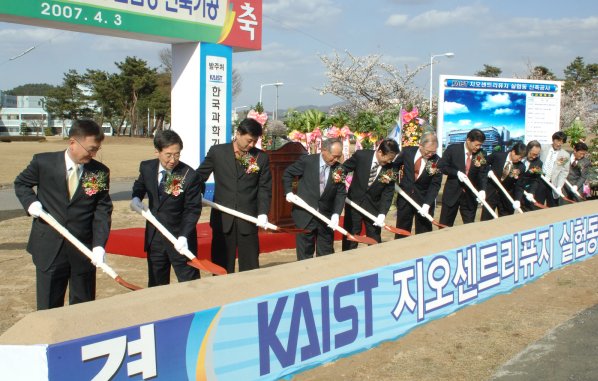event
- Geo-Centrifuge experiment center of an area of about 1,712 square meters and an estimated construction cost of total 8.4 billion won
- Simulation laboratory in the field of geotechnical engineering with state-of-the-art experiment equipment
- Ground-breaking ceremony held on April 3 at 4 pm
KAIST will construct ‘distributed shared-type Geo-Centrifuge experiment center’, a large-scale civil engineering laboratory that will study natural disasters such as earthquake, embankment collapse, etc. with ground structure miniatures.
A two-story building with a basement occupying an area of about 1,712 square meters will become a landmark laboratory in the field of geotechnical engineering that can be used for the education, research, and social infrastructure design by universities, institutes, and corporations via high-speed information and communication network. The estimated construction cost is 8.4 billion won.
The center will be composed of experiment building including geo-centrifuge laboratory, model-making room, workshop, geotechnical engineering laboratory, and specimen storehouse; and research building including control room, video conference room, electronic library, and research rooms. A variety of convenience facilities for researchers and video conference and remote monitoring system, with which researcher at remote distances can directly participate in experiments, will be provided in the research building, and world’s top-class experiment equipment such as geo-centrifuge with a turning radius of 5 meters, a maximum acceleration of 130 G (130 times faster than the acceleration of gravity), a preload of 2,400 kg and bidirectional shaking-table that can reproduce earthquakes-like wave during experiments, and robots that can reproduce construction procedures by a remote control will be installed.
Geo-Centrifuge experiment refers to an experiment that reproduces natural disaster-like motions by making miniatures of large-scale ground structures such as dams, slopes, etc. and using centrifugal forces generated from high-speed rotation. This experiment can easily and rapidly reproduce actual motions of ground structures at a low cost, thereby being widely used for various geotechnical engineering researches such as evaluation of seismic safety, movement of soft ground, slope stability analysis, etc. The causes of the embankment collapse in New Orleans by Hurricane Katrina in 2005 were also revealed by simulation tests by this experiment.
“The center will make possible a variety of experiments and researches that have never been available in Korea due to the lack of experiment infrastructure, therefore activate researches over the design and construction of large-scale social infrastructures. Making possible civil engineering researches demanding the use of large-scale equipment like Centrifuge, severely dependent on overseas technologies so far, will enhance the global competitiveness of Korean construction industry,” said Dong-soo Kim, President of the center.
The center will be constructed as part of the Ministry of Construction & Transportation (MOCT)’s project for the establishment of distributed shared-style construction research infrastructure, which is designed to establish construction research infrastructures in a national level. The ground breaking ceremony was held at KAIST on April 3 at 4 pm.

-
event A heated battle of science and sports, who is the winner of this year's KA-PO War?
< Photos from KAIST-POSTECH Science War (photographed by Student Junhyeok Park of KAIST Freshman Course) > The future leaders of science at KAIST and POSTECH (President Seong Keun Kim) held their annual science and sporting event at POSTECH for two days from September 20th to 21st. The 'KAIST-POSTECH Science War (hereafter KA-PO War)' is a festival consisting of science and sports games and various side events to promote exchange and cooperation between the two universities. It is als
2024-09-19 -
event The 3rd Global Entrepreneurship Summer School (GESS 2024) Successfully Completed in Silicon Valley
The 2024 Global Entrepreneurship Summer School (2024 KAIST GESS), hosted by the Office of Global Initiatives under the KAIST International Office (Director Man-Sung Yim), was held for the third time. This program allows students to visit Silicon Valley, a global startup hub, to directly experience its famous startup ecosystem and develop their capabilities for global expansion. A total of 20 students were selected through applications, interviews, final presentations, mentoring, and peer evaluat
2024-07-03 -
people Dr. Bong-Joon Jung Elected as Interim President of KAIST U.S. Alumni Association
On April 29th, 2024, the Office of Global Initiative at KAIST, led by Vice President Man-Sung Yim, successfully conducted the election for the interim president of the KAIST U.S. Alumni Association. The authority to organize and operate the election was delegated by the KAIST U.S. Alumni Interim President Selection Committee Foundation, consisting of Je Woo Kim, Director of KAIST U.S. Foundation; Terri Kim, Director of KAIST U.S. Foundation; and Myungjin Yim, President of the KAIST Silicon Valle
2024-04-29 -
event Center for Global Strategies and Planning Hosts Successful Virtual KAIST U.S. Alumni Connection Event
< Screen capture of the KAIST U.S. Alumni meeting held online on December 8 > On December 8th, the Center for Global Strategies and Planning at KAIST, led by Vice President Man-Sung Yim of the International Office, conducted a virtual event to bring together KAIST alumni in the United States. The purpose of this event was to showcase KAIST's current initiatives in the U.S., facilitate information exchanges among U.S. alumni, and foster networking opportunities. Over 130 KAIST alumni b
2023-12-08 -
event NYU-KAIST Global AI & Digital Governance Conference Held
< Photo 1. Opening of NYU-KAIST Global AI & Digital Governance Conference > In attendance of the Minister of Science and ICT Jong-ho Lee, NYU President Linda G. Mills, and KAIST President Kwang Hyung Lee, KAIST co-hosted the NYU-KAIST Global AI & Digital Governance Conference at the Paulson Center of New York University (NYU) in New York City, USA on September 21st, 9:30 pm. At the conference, KAIST and NYU discussed the direction and policies for ‘global AI and digit
2023-09-22